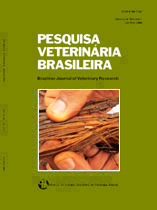 |
|
|
|
Year 2013 - Volume 33, Number 6
|

|
Effects of environmental modification on mastitis occurrence and hormonal changes in Holstein cows, 33(6):826-830
|
ABSTRACT.- Arcaro J.R.P., Matarazzo S.V., Pozzi C.R., Arcaro Junior I., Toledo L.M., Costa E.O. & Miranda M.S. 2013. Effects of environmental modification on mastitis occurrence and hormonal changes in Holstein cows. Pesquisa Veterinária Brasileira 33(6):826-830. Departamento de Ciências Agrárias e Ambientais, Universidade Estadual de Santa Cruz, Rodovia Jorge Amado Km 16, Ilhéus, BA, 45662-900 Brazil. E-mail: svmatarazzo@uesc.br
The purpose of this research was to evaluate the effects of evaporative cooling in freestall on mastitis occurrence, milk production, and composition, as well as cortisol, T3 (triiodothyronine), and T4 (thyroxin) levels in lactating dairy cows. Twenty-eight multiparous cows averaging 70 ± 10 day postpartum were used in four treatments from January to March 2003. The treatments were: Day (cooling from 7:00 a.m. to 7:00 p.m.); Night (cooling from 7:00 p.m. to 7:00 a.m.); 24-hour (cooling 24-hour); and Control (no cooling). Wired cup test was used for clinical mastitis diagnosis, and the California Mastitis Test (CMT) was used to identify subclinical mastitis. Blood and milk samples were taken weekly for microbiological and hormonal analyses. The cortisol levels were higher than normal values in all treatment groups, suggesting stress conditions, but T3 and T4 levels remained normal in all groups. The occurrence of subclinical mastitis was lower in Day and Night groups than in Control and 24-hour groups. Regarding the microbiological analyses, in all groups the isolation of Corynebacterium sp. from milk samples increased while negative coagulase staphylococci (CNS) declined as etiological agents of subclinical mastitis. However, in Day and 24-hour groups, coagulase positive staphylococci (CPS) increased mainly Staphylococcus aureus (49.8% and 47.7% respectively). The Night group showed a decrease in subclinical mastitis occurrences. Our data indicate that all animals subjected to treatments presented high levels of cortisol, indicating a stress condition. The Night treatment presented a reduction in microbial isolation, suggesting a reduced susceptibility to mastitis. |
| |
|
|
| |
|
 |